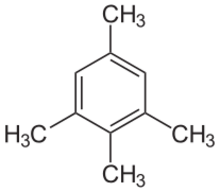Chemistry:Isodurene

| |
| Names | |
|---|---|
| Preferred IUPAC name
1,2,3,5-Tetramethylbenzene | |
| Other names
Isodurene
| |
| Identifiers | |
3D model (JSmol)
|
|
| ChEMBL | |
| ChemSpider | |
| EC Number |
|
PubChem CID
|
|
| UNII | |
| UN number | 1993 |
| |
| |
| Properties | |
| C10H14 | |
| Molar mass | 134.22 |
| Appearance | colorless liquid |
| Density | 0.89 g/cm3 |
| Melting point | −23.7 °C (−10.7 °F; 249.5 K) |
| Boiling point | 198 °C (388 °F; 471 K) |
| 27.9 mg/L | |
| Hazards | |
| Main hazards | Flammable |
| GHS pictograms | 
|
| GHS Signal word | Warning |
| H315, H319 | |
| P264, P280, P302+352, P305+351+338, P321, P332+313, P337+313, P362 | |
| Flash point | 63.3 °C (145.9 °F; 336.4 K) |
Except where otherwise noted, data are given for materials in their standard state (at 25 °C [77 °F], 100 kPa). | |
| Infobox references | |
Isodurene or 1,2,3,5-tetramethylbenzene is an organic compound with the formula C6H2(CH3)4, classified as an aromatic hydrocarbon. It is a flammable colorless liquid which is nearly insoluble in water but soluble in organic solvents. It occurs naturally in coal tar. Isodurene is one of three isomers of tetramethylbenzene, the other two being prehnitene (1,2,3,4-tetramethylbenzene) and durene (1,2,4,5-tetramethylbenzene).[1]
Preparation
Isoodurene can be prepared from mesitylene, which is converted to mesityl bromide. The latter reacts with magnesium to give the Grignard reagent, which can be alkylated with dimethyl sulfate: [2]
Industrially, isodurene can be isolated from the reformed fraction of oil refineries. It may also be produced by methylation of toluene, xylenes, and trimethylbenzenes.[1]
References
- ↑ 1.0 1.1 Griesbaum, Karl; Behr, Arno; Biedenkapp, Dieter; Voges, Heinz-Werner; Garbe, Dorothea; Paetz, Christian; Collin, Gerd; Mayer, Dieter et al. (2002). "Ullmann's Encyclopedia of Industrial Chemistry". Ullmann's Encyclopedia of Industrial Chemistry. Weinheim: Wiley-VCH. doi:10.1002/14356007.a13_227.
- ↑ Lee Irvin Smith (1931). "Isoodurene". Org. Synth. 11: 66. doi:10.15227/orgsyn.011.0066.
 |

